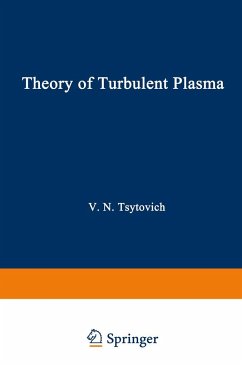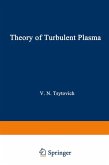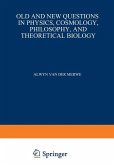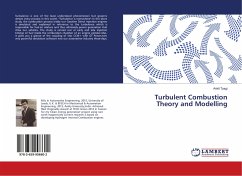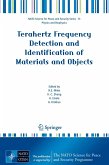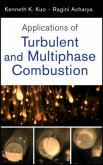V. N. Tsytovich
Theory of Turbulent Plasma
Schade – dieser Artikel ist leider ausverkauft. Sobald wir wissen, ob und wann der Artikel wieder verfügbar ist, informieren wir Sie an dieser Stelle.
V. N. Tsytovich
Theory of Turbulent Plasma
- Gebundenes Buch
- Merkliste
- Auf die Merkliste
- Bewerten Bewerten
- Teilen
- Produkt teilen
- Produkterinnerung
- Produkterinnerung
In the last few years the physics of turbulent plasma has undergone rapid development, beginning with the first works, in which the term "turbulence" was used in various ways, and ending with the fundamental studies which provide a thorough examina tion of the turbulent state of plasma. In physics it is usually found that value is not so much contained in specific results for a partic ular field as it is in the more general outlook and overall view of the problem. Occasionally the older results take on new mean ing after the general view of things is perfected. In the case of the physics of…mehr
Andere Kunden interessierten sich auch für
![Theory of Turbulent Plasma Theory of Turbulent Plasma]() V. N. TsytovichTheory of Turbulent Plasma39,99 €
V. N. TsytovichTheory of Turbulent Plasma39,99 €![Old and New Questions in Physics, Cosmology, Philosophy, and Theoretical Biology Old and New Questions in Physics, Cosmology, Philosophy, and Theoretical Biology]() Alwyn van der MerweOld and New Questions in Physics, Cosmology, Philosophy, and Theoretical Biology77,99 €
Alwyn van der MerweOld and New Questions in Physics, Cosmology, Philosophy, and Theoretical Biology77,99 €![Materials Science of Thin Films Materials Science of Thin Films]() Milton OhringMaterials Science of Thin Films125,99 €
Milton OhringMaterials Science of Thin Films125,99 €![Turbulent Combustion Theory and Modelling Turbulent Combustion Theory and Modelling]() Ankit TyagiTurbulent Combustion Theory and Modelling24,99 €
Ankit TyagiTurbulent Combustion Theory and Modelling24,99 €![Terahertz Frequency Detection and Identification of Materials and Objects Terahertz Frequency Detection and Identification of Materials and Objects]() R.E. Miles / X.-C. Zhang / H. Eisele / A. Krotkus (eds.)Terahertz Frequency Detection and Identification of Materials and Objects149,99 €
R.E. Miles / X.-C. Zhang / H. Eisele / A. Krotkus (eds.)Terahertz Frequency Detection and Identification of Materials and Objects149,99 €![Applications of Turbulent and Multiphase Combustion Applications of Turbulent and Multiphase Combustion]() Kenneth K. KuoApplications of Turbulent and Multiphase Combustion194,99 €
Kenneth K. KuoApplications of Turbulent and Multiphase Combustion194,99 €
In the last few years the physics of turbulent plasma has undergone rapid development, beginning with the first works, in which the term "turbulence" was used in various ways, and ending with the fundamental studies which provide a thorough examina tion of the turbulent state of plasma. In physics it is usually found that value is not so much contained in specific results for a partic ular field as it is in the more general outlook and overall view of the problem. Occasionally the older results take on new mean ing after the general view of things is perfected. In the case of the physics of turbulent plasma, this general picture is now com plete, for the most part. The first review devoted to the problem of plasma turbulence was written by B. B. Kadomtsev [in "Problems in Plasma Theory," edited by M. A. Leontovich, Volume 4, Moscow, Atomizdat (1964), p. 188; English Translation: "Plasma Turbulence," Academic Press, London (1965)].
Produktdetails
- Produktdetails
- Studies in Soviet Science / 1977
- Verlag: Springer, Berlin
- 1977.
- Seitenzahl: 535
- Erscheinungstermin: 1. Februar 1977
- Englisch
- Gewicht: 1g
- ISBN-13: 9780306108945
- ISBN-10: 0306108941
- Artikelnr.: 25534840
- Herstellerkennzeichnung
- Libri GmbH
- Europaallee 1
- 36244 Bad Hersfeld
- gpsr@libri.de
- Studies in Soviet Science / 1977
- Verlag: Springer, Berlin
- 1977.
- Seitenzahl: 535
- Erscheinungstermin: 1. Februar 1977
- Englisch
- Gewicht: 1g
- ISBN-13: 9780306108945
- ISBN-10: 0306108941
- Artikelnr.: 25534840
- Herstellerkennzeichnung
- Libri GmbH
- Europaallee 1
- 36244 Bad Hersfeld
- gpsr@libri.de
1. The Turbulent State of Matter: General Concepts.- 1.1. A Definition of Turbulence.- 1.2. A Statistical Description of Turbulence.- 1.3. The Spectrum of Turbulent Fluctuations in an Incompressible Fluid.- 1.4. Linear Collective Degrees of Freedom in Plasma.- 1.5. Nonlinear Collective Plasma Motions. Strong and Weak Turbulence.- 1.6. Fundamental Problems in the Physics of Turbulent Plasma.- 1.7. Turbulent Plasma in Experiment and Nature.- 2. Basic Concepts of Turbulent Plasma Theory.- 2.1. Statistical Ensemble Averages.- 2.2. Linear Effects in Changes in the Distribution of Turbulent Plasma Fluctuations.- 2.3. Nonlinear Interaction of Turbulent Plasma Fluctuations.- 2.4. The Interpretation of Nonlinear Interactions of Turbulent Fluctuations as Induced Plasmon - Plasmon and Plasmon - Plasma Particle Scattering.- 2.5. The Correlation of Turbulent Fluctuations in Plasma.- 2.6. The Quasilinear Approximation.- 2.7. Correlation of Turbulent Fluctuations and Its Effect on the Interaction with Plasma Particles.- 2.8. Turbulent Resonance Broadening of Particle - Plasmon Interactions.- 2.9. General Balance Equations for the Interactions of Particles and Turbulent Fluctuations.- 2.10. Probability Calculations.- 3. Collective Dissipation and Excitation of Turbulent Fluctuations.- 3.1. Collective Dissipation of Turbulent Fluctuations in Plasma.- 3.2. Turbulence Excitation Mechanisms.- 3.3. The Interaction of a Plasma and a Beam of Charged Particles.- 3.4. Excitation of Turbulence by Anisotropy and Loss-Cone Instabilities.- 3.5. The Excitation of Turbulence by a Constant Electric Field.- 3.6. Excitation of Turbulence in an Inhomogeneous Plasma. Drift Instabilities.- 3.7. The Excitation of Turbulence by Electromagnetic Waves and Lasers.- 3.8. The Generation of Turbulence inCosmic Plasmas.- 4. The Spectra of Stationary Plasma Turbulence.- 4.1. Types of Stationary Plasma Turbulence.- 4.2. Nonlinear Interactions and the Spectral Transfer of Energy of Langmuir Fluctuations in an Isotropic Plasma.- 4.3. The Spectra of Stationary Langmuir Turbulence in Isothermal Plasma.- 4.4. The Spectra of Low-Frequency Fluctuations Excited by Langmuir Turbulence in an Isothermal Plasma.- 4.5. Spectra of Langmuir Fluctuations in a Nonisothermal Plasma.- 4.6. Correlations and Nonlinear Frequency Shifts of Langmuir Fluctuations in Turbulent Plasma.- 4.7. The Effect of Pair Collisions of Particles on the Correlations and Spectra of Langmuir Turbulence.- 4.8. The Spectra of Ion-Acoustic Turbulence.- 4.9. The Effect of a Magnetic Field on the Interactions and Spectra of Longitudinal Plasma Oscillations.- 4.10. Spectra of Turbulence for Whistlers.- 4.11. The Spectra of Magnetohydrodynamic Plasma Turbulence.- 5. Stochastic Particle Acceleration in Turbulent Plasma.- 5.1. General Problems.- 5.2. Stochastic Acceleration of Charged Particles by Langmuir Oscillations.- 5.3. Stochastic Acceleration by High-Frequency Fluctuations in a Magnetoactive Plasma.- 5.4. Stochastic Acceleration of Particles by High-Frequency Electromagnetic Radiation in a Magnetoactive Plasma.- 5.5. Stochastic Particle Acceleration by Low-Frequency Ion-Acoustic Oscillations.- 5.6. Acceleration by Alfven Waves and Magnetoacoustic Oscillations.- 5.7. Charged-Particle Acceleration due to Induced Scattering on Turbulent Fluctuations.- 5.8. Effectiveness of Various Acceleration Mechanisms and Their Influence on Turbulence Spectra.- 6. Radiation from. a Turbulent Plasma.- 6.1. The Problem.- 6.2. Radiation Processes and the Propagation of Electromagnetic Waves in Turbulent Plasma in Terms of the StokesParameters.- 6.3. Emission of Radiation at Frequencies Close to ?pe by Langmuir Turbulence.- 6.4. Emission of Electromagnetic Waves by a Turbulent Plasma in an External Magnetic Field.- 6.5. Radiation from Epithermal and Relativistic Particles in a Turbulent Plasma.- 6.6. The Effect of Radiation from a Turbulent Plasma on the Spectra of Fast Particles.- 7. Propagation of Electromagnetic Waves through Turbulent Plasma.- 7.1. The Problem.- 7.2. General Scattering Theory.- 7.3. Scattering of Electromagnetic Waves in Turbulent Plasma.- 7.4. Amplification of Electromagnetic Waves Propagating in Turbulent Plasma.- 7.5. Fluctuations in Intensities of Electromagnetic Waves when Propagating through Turbulent Plasma.- 8. Electromagnetic Properties of Turbulent Plasma.- 8.1. General Statement of the Problem.- 8.2. Expansions of Collision Integrals in Terms of the Turbulence Energy.- 8.3. The Particle - Turbulent-Fluctuation Collision Integral: Summing The Series.- 8.4. Dielectric Permeability for an Isotropic Turbulent Plasma.- 8.5. Potential Instabilities of an Isotropic Turbulent Plasma.- 8.6. Drift Instabilities in Turbulent Plasma.- 8.7. Spontaneous Excitation of Magnetic Fields in Turbulent Plasma.- 8.8. The Skin Effect in Turbulent Plasma.- 8.9. Second Sound in Turbulent Plasma.- 9. Development of the Concepts of Strong Langmuir Turbulence.- 9.1. Introduction.- 9.2. Excitation of Strong Langmuir Turbulence.- 9.3. Solitons and Cavitons.- 9.4. Limits on the Applicability of Descriptions of Strong Nonlinear Motions and Spikons.- 9.5. Soliton and Caviton Turbulence.- 9.6. The Statistical Theory of Strong Langmuir Turbulence.- 9.7. Conclusion.- References.
1. The Turbulent State of Matter: General Concepts.- 1.1. A Definition of Turbulence.- 1.2. A Statistical Description of Turbulence.- 1.3. The Spectrum of Turbulent Fluctuations in an Incompressible Fluid.- 1.4. Linear Collective Degrees of Freedom in Plasma.- 1.5. Nonlinear Collective Plasma Motions. Strong and Weak Turbulence.- 1.6. Fundamental Problems in the Physics of Turbulent Plasma.- 1.7. Turbulent Plasma in Experiment and Nature.- 2. Basic Concepts of Turbulent Plasma Theory.- 2.1. Statistical Ensemble Averages.- 2.2. Linear Effects in Changes in the Distribution of Turbulent Plasma Fluctuations.- 2.3. Nonlinear Interaction of Turbulent Plasma Fluctuations.- 2.4. The Interpretation of Nonlinear Interactions of Turbulent Fluctuations as Induced Plasmon - Plasmon and Plasmon - Plasma Particle Scattering.- 2.5. The Correlation of Turbulent Fluctuations in Plasma.- 2.6. The Quasilinear Approximation.- 2.7. Correlation of Turbulent Fluctuations and Its Effect on the Interaction with Plasma Particles.- 2.8. Turbulent Resonance Broadening of Particle - Plasmon Interactions.- 2.9. General Balance Equations for the Interactions of Particles and Turbulent Fluctuations.- 2.10. Probability Calculations.- 3. Collective Dissipation and Excitation of Turbulent Fluctuations.- 3.1. Collective Dissipation of Turbulent Fluctuations in Plasma.- 3.2. Turbulence Excitation Mechanisms.- 3.3. The Interaction of a Plasma and a Beam of Charged Particles.- 3.4. Excitation of Turbulence by Anisotropy and Loss-Cone Instabilities.- 3.5. The Excitation of Turbulence by a Constant Electric Field.- 3.6. Excitation of Turbulence in an Inhomogeneous Plasma. Drift Instabilities.- 3.7. The Excitation of Turbulence by Electromagnetic Waves and Lasers.- 3.8. The Generation of Turbulence inCosmic Plasmas.- 4. The Spectra of Stationary Plasma Turbulence.- 4.1. Types of Stationary Plasma Turbulence.- 4.2. Nonlinear Interactions and the Spectral Transfer of Energy of Langmuir Fluctuations in an Isotropic Plasma.- 4.3. The Spectra of Stationary Langmuir Turbulence in Isothermal Plasma.- 4.4. The Spectra of Low-Frequency Fluctuations Excited by Langmuir Turbulence in an Isothermal Plasma.- 4.5. Spectra of Langmuir Fluctuations in a Nonisothermal Plasma.- 4.6. Correlations and Nonlinear Frequency Shifts of Langmuir Fluctuations in Turbulent Plasma.- 4.7. The Effect of Pair Collisions of Particles on the Correlations and Spectra of Langmuir Turbulence.- 4.8. The Spectra of Ion-Acoustic Turbulence.- 4.9. The Effect of a Magnetic Field on the Interactions and Spectra of Longitudinal Plasma Oscillations.- 4.10. Spectra of Turbulence for Whistlers.- 4.11. The Spectra of Magnetohydrodynamic Plasma Turbulence.- 5. Stochastic Particle Acceleration in Turbulent Plasma.- 5.1. General Problems.- 5.2. Stochastic Acceleration of Charged Particles by Langmuir Oscillations.- 5.3. Stochastic Acceleration by High-Frequency Fluctuations in a Magnetoactive Plasma.- 5.4. Stochastic Acceleration of Particles by High-Frequency Electromagnetic Radiation in a Magnetoactive Plasma.- 5.5. Stochastic Particle Acceleration by Low-Frequency Ion-Acoustic Oscillations.- 5.6. Acceleration by Alfven Waves and Magnetoacoustic Oscillations.- 5.7. Charged-Particle Acceleration due to Induced Scattering on Turbulent Fluctuations.- 5.8. Effectiveness of Various Acceleration Mechanisms and Their Influence on Turbulence Spectra.- 6. Radiation from. a Turbulent Plasma.- 6.1. The Problem.- 6.2. Radiation Processes and the Propagation of Electromagnetic Waves in Turbulent Plasma in Terms of the StokesParameters.- 6.3. Emission of Radiation at Frequencies Close to ?pe by Langmuir Turbulence.- 6.4. Emission of Electromagnetic Waves by a Turbulent Plasma in an External Magnetic Field.- 6.5. Radiation from Epithermal and Relativistic Particles in a Turbulent Plasma.- 6.6. The Effect of Radiation from a Turbulent Plasma on the Spectra of Fast Particles.- 7. Propagation of Electromagnetic Waves through Turbulent Plasma.- 7.1. The Problem.- 7.2. General Scattering Theory.- 7.3. Scattering of Electromagnetic Waves in Turbulent Plasma.- 7.4. Amplification of Electromagnetic Waves Propagating in Turbulent Plasma.- 7.5. Fluctuations in Intensities of Electromagnetic Waves when Propagating through Turbulent Plasma.- 8. Electromagnetic Properties of Turbulent Plasma.- 8.1. General Statement of the Problem.- 8.2. Expansions of Collision Integrals in Terms of the Turbulence Energy.- 8.3. The Particle - Turbulent-Fluctuation Collision Integral: Summing The Series.- 8.4. Dielectric Permeability for an Isotropic Turbulent Plasma.- 8.5. Potential Instabilities of an Isotropic Turbulent Plasma.- 8.6. Drift Instabilities in Turbulent Plasma.- 8.7. Spontaneous Excitation of Magnetic Fields in Turbulent Plasma.- 8.8. The Skin Effect in Turbulent Plasma.- 8.9. Second Sound in Turbulent Plasma.- 9. Development of the Concepts of Strong Langmuir Turbulence.- 9.1. Introduction.- 9.2. Excitation of Strong Langmuir Turbulence.- 9.3. Solitons and Cavitons.- 9.4. Limits on the Applicability of Descriptions of Strong Nonlinear Motions and Spikons.- 9.5. Soliton and Caviton Turbulence.- 9.6. The Statistical Theory of Strong Langmuir Turbulence.- 9.7. Conclusion.- References.

